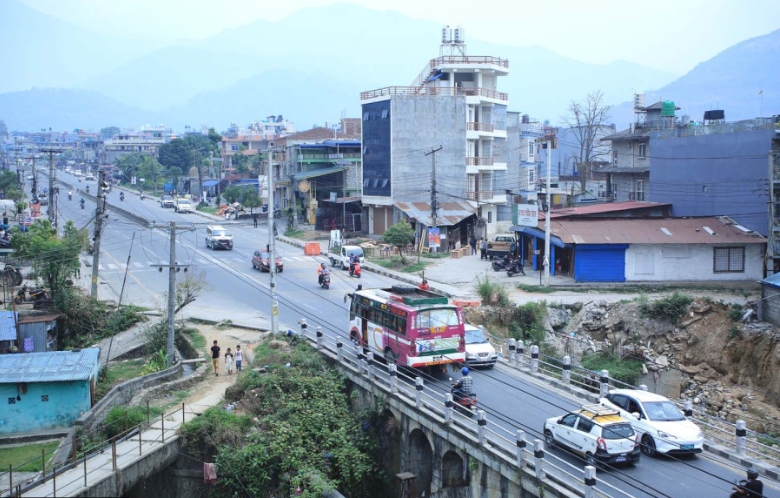
SATV 3 May, Kathmandu :Pokhara, the country's major tourist hub, saw the inauguration of a modern six-lane road stretching from Zero Kilometer to Bindhyabasini Temple in 2017. Hailed as the first of its kind in Gandaki Province, this ‘model road’ was celebrated as a milestone in regional infrastructure.
However, one critical component was left behind. The bridge over the Phirke stream remains a narrow and outdated two-lane structure. Though plans for a new wider bridge were in place and contracts awarded, it was never built.
Disputes over compensation for the land acquired for the bridge and the contractor’s negligence stalled construction for six years. Now, even after the contract was cancelled, it could take at least three more years to complete the project under a new tender.
“We were hopeful that the road and bridge would be built simultaneously. But no progress was made. Every year, 8 to 9 motorcycles and two to four other vehicles fall off the bridge. It’s become an accident-prone zone,” Sanjiv Bahadur Koirala, a local resident.
The Phirke bridge lies on the busy Bhupi Sherchan (Pokhara–Baglung) Highway. At its entrance, a stark message greets passersby, mainly the drivers: “Caution: Accident-prone area.” It’s not the only warning — several signs installed by the District Traffic Police Office of Kaski line the route. The bridge is dangerously narrow along the upgraded six-lane roadway.
Had the new bridge been constructed simultaneously with the road upgrade, these warnings might never have been necessary. But bureaucratic inefficiency and contractor irresponsibility have left this vital infrastructure in limbo, making the site a symbol of how mismanagement can cripple even the flagship projects. The Phirke bridge saga highlights not just the failure of one contractor but also systemic flaws in the planning, procurement and implementation of infrastructure in the country.
The road construction began in 2014, and by 2017, the 3-kilometer stretch from Zero Kilometer to Bindhyabasini was widened to six lanes. However, due to budget constraints, the bridge over the Phirke stream was excluded from the project.
In 2018, the Division Road Office, Pokhara signed a contract with Shanti–Arogya JV, Lalitpur, to build two new bridges—each 50 meters long and 11 meters wide—flanking the existing two-lane bridge. As per the project agreement, construction should have been completed by mid-April 2021. However, even after three deadline extensions, only around 25 percent of the physical work had been completed so far.
Delays were compounded by unresolved compensation issues. The contract was signed before settling land disputes. The Covid pandemic also disrupted progress. By mid-2022, compensation had been finally distributed to 30 of the 31 affected landowners, yet the contractor remained sluggish, showing no urgency.
Even high-level intervention failed to make a difference. In February 2023, the then deputy prime minister and minister for physical infrastructure Narayan Kaji Shrestha visited the site and instructed the contractor to complete the bridges on time and even warned of consequences if the deadline was missed. But the bridge project was left incomplete.
Eventually, the Division Road Office canceled the contract. “Despite three extensions and repeated follow-ups, there was no meaningful progress. We had to move forward with a new procurement process,” said Nabaraj Bastola, chief of the division office.
After the project cancellation, the contractor filed a writ petition in the Supreme Court, which ordered the Division Road Office to halt any recovery of advance payments until a final decision. As a result, the government has been unable to recover an advance payment of Rs 18 million, part of the Rs 39.1 million already disbursed.
According to Division Office spokesperson Dhruva Pokhrel, the office has recommended blacklisting the contractor under provisions of the Public Procurement Act, and Regulations. Efforts are also underway to recover the remaining funds as government dues, including interest and penalties.
The Ministry of Finance is now expected to ensure funding for a new round of bidding. However, even if the tender process starts immediately, the new bridge is unlikely to be completed before 2028.
In the meantime, the Phirke bridge remains a major safety hazard. The abrupt transition of a six-lane road to a narrow two-lane bridge creates a dangerous bottleneck and increases the risk of accidents.
According to the Kaski District Traffic Police, 94 accidents have occurred near the bridge, within 100 meters, since bridge construction began. These incidents have left 108 people injured. The area lacks alternative routes, forcing pedestrians and drivers alike to rely on the same congested, risky path.
“There’s no space for pedestrians. The solar lights are broken. Many accidents happen because speeding drivers can’t apply brakes in time or lose control before reaching the bridge,” said Kanchan Thapa Koirala, another local resident. She estimates that at least 8 to 10 people have lost their lives in road accidents since 2017.



















